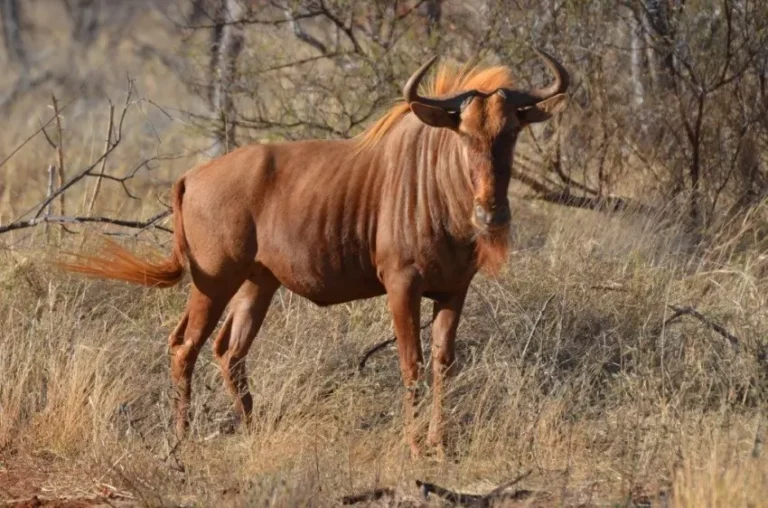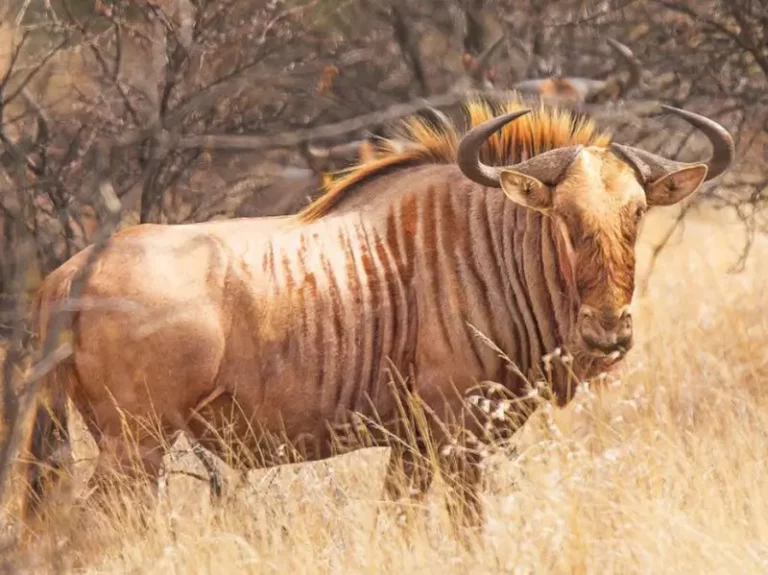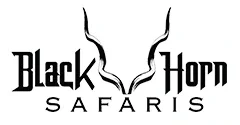Hunting Golden Wildebeest offers an unparalleled safari experience for seasoned hunters. Originating from the Tuli block in Botswana, the Golden Wildebeest—also known as the “golden gnu”—is a rare and striking color variation of the common Blue Wildebeest. Characterized by its distinctive golden color and robust, appearance, this rare animal presents a unique challenge to hunters who venture into the vast African bushveld. This article will provide all the information you need to plan a hunt including prices, hunting packages, the best areas, rifle calibers and archery equipment.

Description and Characteristics
The Golden Wildebeest, is a stunning and rare color morph of the Blue Wildebeest. With a striking golden coat that glistens under the African sun, this unique animal commands attention and admiration. The distinctive hue results from a recessive gene, making the Golden Wildebeest a truly exceptional sight in the wild bushveld. Beyond its coloration, this fascinating animal shares many characteristics with the Blue Wildebeest, such as its muscular build, broad shoulders, and sturdy legs, adaptations that enable it to thrive in the diverse landscapes of Africa. One of the most prominent features of the Golden Gnu is its formidable set of horns, which can reach impressive lengths and serve as a powerful defense mechanism against predators. Golden Gnu originate from the Tuli Block in Botswana.
Trophy Size
For hunters seeking the prestige of a singularly remarkable trophy, the Golden Wildebeest offers something special. Trophy sized Golden Gnu horns typically span between 28 and 30 inches in length, with the most outstanding specimens exceeding 32 inches. The horn bases, which can reach a circumference of 9 inches or more, are also an essential factor in evaluating the trophy quality. As with the Blue Wildebeest, the Golden Wildebeest’s horn structure showcases a unique, inward curving shape that tapers to sharp tips. A prized Golden Wildebeest trophy, with its distinctive coloration and imposing horns, serves as a lasting reminder of the hunt and connection to the awe inspiring wilderness of the African bushveld. Minimum for entry into Rowland Wards records is 28 1/2 and Safari Club International 70.
World Record
Rowland Ward Records of Big Game does not recognize the Golden Wildebeest as a separate species but considers this a color variation of the Blue Wildebeest.
Best Locations for Hunting Golden Wildebeest
The pursuit of the elusive Golden Wildebeest requires venturing into the heart of South Africa, where these rare animals thrive in their natural habitat. South Africa stands out as the premier destination for Golden Gnu hunting, with the Limpopo Province and Eastern Cape offering vast stretches of wilderness that provide optimal conditions for these unique animals. Neighboring countries, such as Namibia and Botswana, also offer good hunting opportunities. Private game reserves and hunting concessions within these regions play a crucial role in the sustainable management of Golden Gnu populations, ensuring that hunting practices align with conservation efforts.
Rifles and Calibers for a Wildebeest Hunt
Selecting the appropriate rifle and caliber for Wildebeest hunting is a crucial part of safari planning. These robust and resilient animals require a rifle capable of delivering sufficient hitting power and accuracy at varying distances. A medium to large caliber rifle is recommended for pursuing Golden Wildebeest, with popular choices including the .30-06 Springfield, .308 Winchester, 9.3 X 62 and the venerable .375 H&H Magnum. Bullet choice is equally important, premium soft-point or bonded bullets being the preferred options for achieving optimal penetration and energy transfer. Bullet weight should be between 180 and 250 grains. When selecting a rifle and caliber, hunters should take into consideration their individual experience, shooting proficiency, and comfort with recoil, as these factors can significantly influence the outcome of the hunt.
Rifle Scopes for Hunting
Reliable rifle scopes and optics play a crucial role in enhancing a hunter’s overall success. Considering the diverse landscapes and variable shooting distances encountered in the African savannah, a versatile scope with variable magnification is highly recommended. A quality 3-9×40 or 4-12×50 scope will provide ample magnification for most situations, while still offering a wide field of view for quick target acquisition. Opt for scopes with multi-coated lenses to ensure maximum light transmission and clarity, even in low-light conditions.
In addition to the rifle scope, a quality pair of binoculars is indispensable for spotting and assessing potential trophies from a distance. Binoculars with 8x or 10x magnification and a large objective lens such as 42mm or 50mm, will allow for optimal light gathering and image sharpness. Rangefinders can also be invaluable for determining accurate distances to the quarry, ensuring proper shot placement and reducing the likelihood of wounding the animal.

Best Shot Placement on Golden Gnu
Achieving the correct shot placement is of paramount importance when pursuing the Golden Gnu, as it significantly contributes to an efficient and humane harvest, minimizing the chance of wounding. The ideal target area is the vital triangle, which encompasses the heart and lungs, ensuring a quick and clean kill when the shot is accurately placed. To locate this zone, hunters should aim for the point where the animals front leg meets its body, positioning the shot slightly behind the shoulder and roughly one-third of the way up from the bottom of the chest.
For the quartering away shot concentrate on having the bullet exit on the opposite front shoulder, this will ensure that the shot reaches the vitals.
Broadside and quartering-away shots are typically the most favorable angles for achieving optimal shot placement, as they provide the largest target area and the greatest probability of reaching the vitals. It is essential to remain patient and wait for the animal to present an ideal shot opportunity, avoiding low-percentage shots.
Bow Hunting Wildebeest
Bow hunting Golden Wildebeest presents an exhilarating challenge that demands skill, stealth, and patience. This traditional and primal hunting method allows the hunter to forge an intimate connection with the African Bush and wildlife, as they rely on their skill and experience to outsmart their quarry. Bow hunting Golden Gnu requires a meticulous approach, as the hunter must carefully close the distance between themselves and the animal, to within 30-40 yards, without alerting it to their presence.
Mastering the art of camouflage and utilizing natural cover, such as bushes and trees, are crucial for achieving the necessary proximity for an effective and ethical shot. Hunters must also possess a keen understanding of the Golden Wildebeest’s behavior, movement patterns, and preferred habitat, as this knowledge will enhance their ability to predict the animal’s actions and plan their approach accordingly.
Probably the most successful method is ambushing the animals from a ground blind or tree stand. A well positioned blind over feed or water will bring the quarry into effective shooting range and present the highest probability of success shot opportunities.
Bow Equipment for Golden Wildebeest
A powerful compound, traditional bow or crossbow with a draw weight of at least 60-70 pounds is recommended, providing sufficient kinetic energy to penetrate the animal’s rib cage and reach the vital organs. Arrows should be made from durable carbon fiber or aluminum, with a total weight of approximately 450-550 grains for optimal penetration.
Broad heads play a critical role in delivering a quick and humane kill, and choosing the right one is crucial. Fixed-blade or mechanical broad heads with razor-sharp edges and a cutting diameter of at least one and a quarter inch are ideal for achieving maximum penetration and a swift harvest.
Golden Wildebeest Prices and costs of a Hunting Safari
The standalone trophy fee or price to hunt a Golden Wildebeest is $ 3 150.
This price does not include the day fee of $ 350 per hunter per day, hunting 2 on 1 (Two hunters sharing one Professional Hunter).
A five day hunt including the day fee and trophy fee will cost $ 4 900.
Golden Wildebeest Packages
A Golden Wildebeest and Blue Wildebeest hunting package will cost $ 6 700.
This is a fully guided 7 day package including 1 X Golden Wildebeest and 1 X Blue Wildebeest.
Golden Wildebeest, Zebra, Impala and Warthog package will cost $ 8 000.
This is a 7 day package including 1 X Golden Wildebeest, 1 X Zebra, 1 X Impala and 1 X Warthog.
Included in these package hunts:
- Accommodation in a lodge
- Meals
- Water and soft drinks
- The services of a Professional Hunter
- Field preparation of trophies
- Delivery of trophies to the Taxidermist
- Road transportation to and from Johannesburg International Airport
References
- Thompson, A. R., & Davis, L. M. (2022). Ecological and Genetic Implications of Golden Wildebeest Hunting in South Africa. Wildlife Research, 48(3), 210-225.
- Johnson, P. S., & Anderson, R. W. (2021). Golden Wildebeest, Conservation and Sustainable Hunting Practices in Southern Africa. Journal of Wildlife Management, 39(2), 145-160.
- South African Department of Environmental Affairs and Tourism. (2023). Golden Wildebeest, Hunting Regulations and Conservation Initiatives in South Africa.
FAQ’S Frequently asked Questions
What does it cost to hunt a Golden Gnu in Africa?
The standalone trophy fee or price to hunt a Golden Wildebeest is $ 3 150.
A five day hunt including the day fee and trophy fee will cost $ 4 900.
Where is the best place to hunt a Golden Gnu?
The best place to hunt Golden Wildebeest is the Limpopo province of South Africa. Numerous private game farms and concessions in this region play a crucial role in the sustainable management of Golden Gnu populations, ensuring that hunting practices align with conservation efforts.
Where are Golden Wildebeest found?
South Africa stands out as the premier destination for Golden Gnu, with the Limpopo Province and Eastern Cape offering vast stretches of wilderness that provide optimal conditions for these unique animals. Neighboring countries, such as Namibia and Botswana, also offer good hunting opportunities. Golden Gnu originated in the Tuli block in Botswana.

Adrian Anderson first obtained his Professional Hunters license in 1991. He is a Big Five and Dangerous Game licensed Professional Hunter and Hunting Outfitter. He has a tremendous love for wildlife and the African bush and enjoys sharing his knowledge with the hunting clients that he guides. Guiding hunters in Africa’s wild places is a passion and seeing them succeed with their goals brings satisfaction. With knowledge of the Safari industry built up over 32 years he is well qualified to give guidance to his hunting clients.
